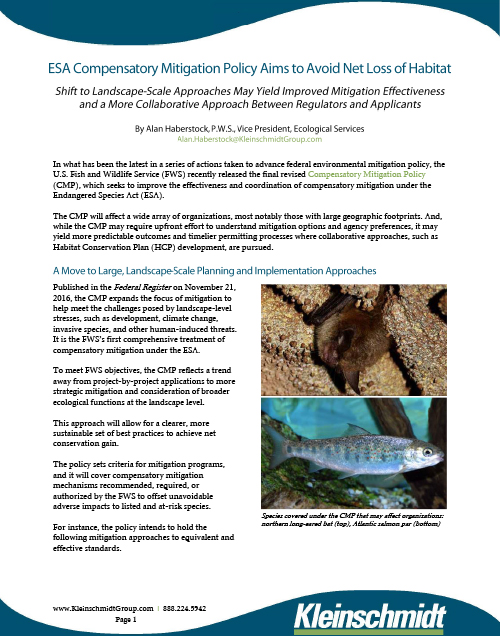Shift to Landscape-Scale Approaches May Yield Improved Mitigation Effectiveness and a More Collaborative Approach Between Regulators and Applicants
By Alan Haberstock, P.W.S., Vice President, Ecological Services
 In what has been the latest in a series of actions taken to advance federal environmental mitigation policy, the U.S. Fish and Wildlife Service (FWS) recently released the final revised Compensatory Mitigation Policy (CMP), which seeks to improve the effectiveness and coordination of compensatory mitigation under the Endangered Species Act (ESA).
In what has been the latest in a series of actions taken to advance federal environmental mitigation policy, the U.S. Fish and Wildlife Service (FWS) recently released the final revised Compensatory Mitigation Policy (CMP), which seeks to improve the effectiveness and coordination of compensatory mitigation under the Endangered Species Act (ESA).
The CMP will affect a wide array of organizations, most notably those with large geographic footprints. And, while the CMP may require upfront effort to understand mitigation options and agency preferences, it may yield more predictable outcomes and timelier permitting processes where collaborative approaches, such as Habitat Conservation Plan (HCP) development, are pursued.
 A Move to Large, Landscape-Scale Planning and Implementation Approaches
A Move to Large, Landscape-Scale Planning and Implementation Approaches
Published in the Federal Register on November 21, 2016, the CMP expands the focus of mitigation to help meet the challenges posed by landscape-level stresses, such as development, climate change, and other human-induced threats. It is the FWS’s first comprehensive treatment of compensatory mitigation under the ESA.
To meet FWS objectives, the CMP reflects a trend away from project-by-project applications to more strategic mitigation and consideration of broader ecological functions at the landscape level.
This approach will allow for a clearer, more sustainable set of best practices to achieve net conservation gain.
 The policy sets criteria for mitigation programs, and it will cover compensatory mitigation mechanisms recommended, required, or authorized by the FWS to offset unavoidable adverse impacts to listed and at-risk species.
The policy sets criteria for mitigation programs, and it will cover compensatory mitigation mechanisms recommended, required, or authorized by the FWS to offset unavoidable adverse impacts to listed and at-risk species.
For instance, the policy intends to hold the following mitigation approaches to equivalent and effective standards.
- Permittee-ResponsibleMitigation: Permitteeretains responsibility for successful compensatory mitigation through restoration, establishment, enhancement,and preservation on site or at another location.
 Conservation Banking: Permittee purchases credits from bank owners, who use the money to protect off-site lands that are permanently managed for species that are endangered, threatened, candidates for listing, or otherwise at risk.
Conservation Banking: Permittee purchases credits from bank owners, who use the money to protect off-site lands that are permanently managed for species that are endangered, threatened, candidates for listing, or otherwise at risk.
- In-Lieu Fee Programs: Permittee makes a payment to a government or nonprofit in-lieu fee program that conducts restoration, creation, enhancement, or preservation activities.
- Habitat Credit Exchanges: Permittee purchases credits from private landowners, such as farmers, who use the money to maintain and improve habitat on their property.
 Following the Model of Compensatory Wetland Mitigation
Following the Model of Compensatory Wetland Mitigation
Anyone familiar with wetland mitigation will find numerous parallels with how the CMP may function in practice. Compensatory Mitigation for Losses of Aquatic Resources, which was adopted in 2008 by the Environmental Protection Agency (EPA) and Department of Army, expanded Section 404(b)(1) guidelines to include standards for all compensatory mitigation mechanisms. It uses similar logic to the proposed FWS policy.
 For instance, like the CMP, it takes a landscape-scale approach to ensuring that, at a minimum, actions result in no net loss toward achieving conservation outcomes.
For instance, like the CMP, it takes a landscape-scale approach to ensuring that, at a minimum, actions result in no net loss toward achieving conservation outcomes.
Kleinschmidt’s recent experience preparing large-scale mitigation plans for linear projects corroborates this trend. Decades ago, the U.S. Army Corps of Engineers (USACE) often allowed mitigation designs that were isolated and functioned poorly, such as an upland excavation that pooled water but was functionally detached from a connected wetland system.
 Today, the USACE districts we work with are requiring mitigation to focus on no net loss of wetland function, as well as consideration of “watershed-scale” functions and services.
Today, the USACE districts we work with are requiring mitigation to focus on no net loss of wetland function, as well as consideration of “watershed-scale” functions and services.
Increasingly, the idea of using ratios (e.g., 2 acres of mitigation for 1 acre of impact would be considered a 2:1 ratio) has been replaced by analyses of net “functional lift.”
This may result in lower acreage ratios where marginal habitats are affected, as well as higher ratios where high-quality habitats are affected.
 Both the CMP and Section 404 guidelines support using the following three-step hierarchy to determine the type and level of mitigation.
Both the CMP and Section 404 guidelines support using the following three-step hierarchy to determine the type and level of mitigation.
1. Avoid any adverse impacts.
2. Minimize unavoidable adverse impacts with appropriate and practicable steps.
3. Compensate for unavoidable adverse impacts that remain.
When steps one and two are followed, often no mitigation is required. However, most large-scale linear projects result in some level of unavoidable impact and resulting mitigation.
Recommendations: Embracing a Proactive Approach to Ensure ESA Compliance
Now that the policy guidelines are final, we recommend that organizations begin investing more time up front talking with federal officials to understand ESA compliance, their mitigation options, and the expectations and requirements of applicable federal agencies.
As with compensatory wetland mitigation, the long-term benefits of proactive planning may outweigh the investment. So, we recommend that clients with large geographic footprints consider developing HCPs that include a mitigation approach consistent with CMP guidelines.
By incorporating compensatory mitigation measures into their landscape-scale conservation plans or HCPs, organizations will be poised to enjoy greater regulatory certainty and quicker permitting processes. Also, they will be more likely to obtain Incidental Take Permits (ITPs) to address the long-term risk of developing and operating projects over time.
Finally, for large-scale projects with unavoidable impacts, we recommend that organizations work with a mitigation specialist early in the process. This will ensure that ESA guidelines are met and associated long-term cost and time savings are achieved.
Hopefully, the approach advocated in these guidelines will result in more effective conservation outcomes while, at the same time, affording applicants more planning control for large project footprints that require ESA consultation.
